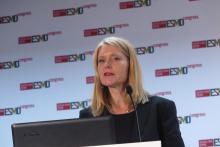BARCELONA – Patients with than patients treated with chemotherapy, reported investigators in the Checkmate 227 trial.
Among 793 patients with treatment-naive metastatic NSCLC with programmed death-ligand 1 (PD-L1) expression of at least 1%, median overall survival (OS) was 17.1 months for patients treated with the combination versus 14.9 months for patients treated with chemotherapy, a difference that translated into a hazard ratio with the combination of 0.79 (P = .007). Two-year overall survival rates were 40% and 32.8%, respectively.
The improvement in OS with the combination occurred regardless of PD-L1 status, suggesting that it can be a chemotherapy-free option for patients with previously untreated metastatic NSCLC, Solange Peters, MD, of Centre Hospitalier Universitaire Vaudois, Lausanne, Switzerland, said at the European Society for Medical Oncology Congress.
Checkmate 227 “is the first phase 3 study proving the concept in an evidence-based fashion of the combination of CTLA4 and anti–PD-1/PD-L1 in non–small cell lung cancer,” Dr. Peters said at a briefing prior to her presentation of the data in a symposium.
CheckMate 227 investigators enrolled patients with stage IV or recurrent NSCLC who had not received any treatment previously. Part one of the multipart study was designed to compare different nivolumab-based regimens versus chemotherapy in patients with PD-L1 expression of 1% or greater, or less than 1%.
The trial has two independent primary endpoints, the first of which, progression-free survival (PFS) with nivolumab and ipilimumab versus chemotherapy, was reported at the 2018 annual meeting of the American Association for Cancer Research.
Dr. Peters presented the overall survival endpoint at ESMO 2019. Results of the study were published simultaneously in the New England Journal of Medicine (2019 Sep 28. doi: 10.1056/NEJMoa1910231).
In part one of the trial, patients with PD-L1 expression of at least 1% (1,189 patients) were randomized on a 1:1:1 basis to one of three treatment options: nivolumab plus low-dose ipilimumab, nivolumab alone, or histology-based chemotherapy. Patients with PD-L1 expression less than 1% (550 patients) were randomized to nivolumab plus low-dose ipilimumab, nivolumab plus chemotherapy, or chemotherapy.
The survival benefit seen with the immunotherapy combination was durable, with 2-year OS rates of 40% for nivolumab/ipilimumab versus 32.8% for chemotherapy. The median durations of response were 23.2 months vs. 6.2 months, respectively.
Patients with low or no PD-L1 expression levels also benefited from the immunotherapy combination, with a median OS of 17.2 months with nivolumab plus ipilimumab, compared with 12.2 months with chemotherapy.
Among all enrolled patients, the median OS duration was 17.1 months with nivolumab plus ipilimumab versus 13.9 months with chemotherapy.
Grade 3 or 4 treatment-related adverse events in the overall study population occurred in 32.8% of patients treated with combined immunotherapy and in 36% of those treated with chemotherapy.
“A key question remains: Is the addition of ipilimumab providing additional benefit on top of nivolumab?” Dr. Peters asked. The answer to that question appears to be “yes,” she said, pointing to a comparison of OS among patients with PD-L1 expression below 1%. Although this subanalysis was not powered for statistical significance, the survival curves indicated a significant advantage for the combination, compared with nivolumab alone or chemotherapy, with respective median OS rates of 17.2, 15.2, and 12.2 months.
“What have we learned from Checkmate 227 so far? Caveat emptor – buyer beware. Beware of the adverse event profile for this doublet chemotherapy combination,” said Sanjay Popat, MD, PhD, of the Royal Marsden Hospital in London, who was the invited discussant at the symposium.
He noted that among PD-L1–positive patients, the OS benefit appears to be driven by patients with high levels of PD-L1 expression (50% or greater).
Additional questions that need addressing, he said, include how immune-related adverse events evolve over time; whether the combination can be made less toxic without impairing efficacy; and what is the optimum duration, dosing, and scheduling of ipilimumab.
“What is the promise of [Checkmate] 227? The promise of the 227 is to have long-lasting responses. That means long life for our patients with a chemo-sparing regimen,” commented Marina Garassino, MD, from the Istituto Nazionale dei Tumori in Milan, who was the invited discussant at the presymposium briefing.
“At the same time, we have to go back to the bench, to the scientists, and to ask the scientists to [help us] understand who are the patients to be treated with the combination of immunotherapy and immunotherapy, with the combination of chemotherapy and immunotherapy, and just with a single agent,” she said.
The study was funded by Bristol-Myers Squibb. Dr. Peters reported a consultant/advisory role, speakers bureau activity, and research support from BMS and others. Dr. Popat disclosed honoraria from BMS and others. Dr. Garrassino disclosed personal fees from BMS and others.
SOURCE: Hellmann MD et al. ESMO 2019. N Engl J Med. 2019 Sep 28. doi: 10.1056/NEJMoa1910231.



